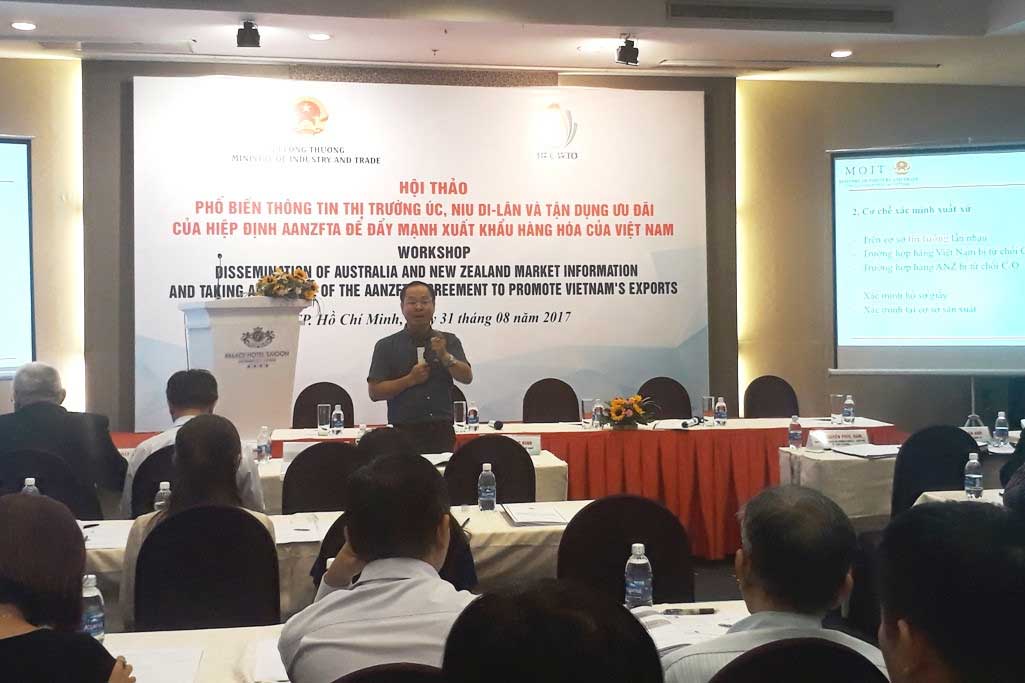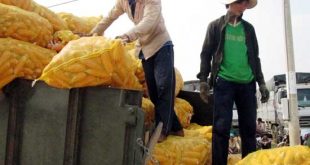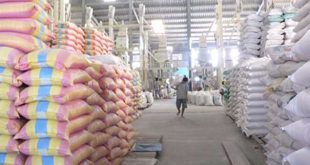According to the ASEAN-Australia-New Zealand Free Trade Area (AANZFTA), countries agreed to reduce 90-100% of their total tariff lines between 2010 and 2020.

In order to provide necessary and useful information for businesses in the south, on August 31 in Ho Chi Minh City, the Asia-Africa Market Department (Ministry of Industry and Trade) WTO accession assistance Ho Chi Minh City organized a workshop disseminating information market Australia, New Zealand and take advantage of the AANZFTA Agreement to promote the export of goods of Vietnam.
Mr. Nguyen Phuc Nam, Deputy Director of Asian-African Market Department, said that the AANZFTA (signed on February 27, 2009, effective from January 1, 2010) plays a very important role in push economic, trade and investment relations between ASEAN and Australia, New ZeaLand.
Under the AANZFTA, countries agreed to cut from 90-100% of the total tariff lines between 2010 and 2020. In particular, Australia and New Zealand are potential export markets for many Power products such as agricultural products, seafood, coffee, cashew nuts, computers, telephones, electronic products, textiles and footwear, etc. are also mostly cut. 0%.
Statistics from the Ministry of Industry and Trade, after more than six years of implementation of the AANZFTA Agreement, Vietnam – Australia export turnover reached $ 5.26 billion, up 6.5% over 2015; an average increase of 4.7% per year for the period 2010-2016. However, the potential of Vietnam’s exports to Australia will be very large because at present, the export value from Vietnam to this country is still very modest, at about 1.6% of the total export value. import into Australia market.
In the first six months of 2017, many of Vietnam’s exports to Australia continued to grow satisfactorily. Phones and accessories increased by 22% over the same period last year. Similarly, footwear of all kinds increased by over 20%, cashew nut increased by nearly 18%, textiles increased over 3.2%, but seafood increased only over 0.5%.
For the New Zealand market, in 2016, the total import and export turnover of Vietnam and this country reached over $ 707 million. Two-way trade between the two countries in recent years increased over 26% per year.
Tariff preference utilization is low
Pham Tuan Anh, deputy director of the International Cooperation Department under the Ministry of Finance, said that the share of Vietnamese exports to Australia in the period 2014-2016 is 18% of total exports from other countries. in ASEAN into this market. However, the rate of goods taking advantage of preferential tariffs from the AANZFTA Agreement of Vietnamese exporters was only about 21.4% because many enterprises did not meet the requirements of the preferential treatment from the Agreement. .
Accordingly, in order to benefit from tax from AANZFTA with many key commodities of Vietnam with the tax rate of 0%, thereby enhancing the competitiveness of products, enterprises need to know the incentive information, procedures clearance; fully understand and meet the criteria of origin, including value added.
At the seminar, many businesses are exporting to Australia and New Zealand, said consumers in these markets are very open to imported goods, not so much of the source of origin, but the specialty. Special attention to quality factors, styles and prices.
Brian O’Reilly, former president of the Australian Chamber of Commerce in Vietnam (AusCham), said Australia views Vietnam as the fastest growing trading partner in the country in Southeast Asia. Two-way trade increased from $ 32.3 million in 1990 to more than $ 5 billion in 2016. Currently, about 300,000 Vietnamese live and work in Australia, which is also one of the key factors for Vietnamese enterprises increase exports to this market.
Mr. Brian O’Reilly also noted that businesses that want to export successfully in the Australian market should meet the rules and regulations when exporting to this market.
In addition, it is essential to understand and prepare for the risks that enterprises may face when exporting, such as: exchange rates, transportation, quarantine or legal issues, as this will Help businesses minimize the risks encountered.
Recently, Vietnam was the first country to export dragon fruits to Australia – the country with the most stringent technical barriers in the world for management of production, import and export of agricultural products. This is a good signal, opening up export prospects for Vietnamese enterprises, especially agricultural products.
(According to baodautu.vn)



